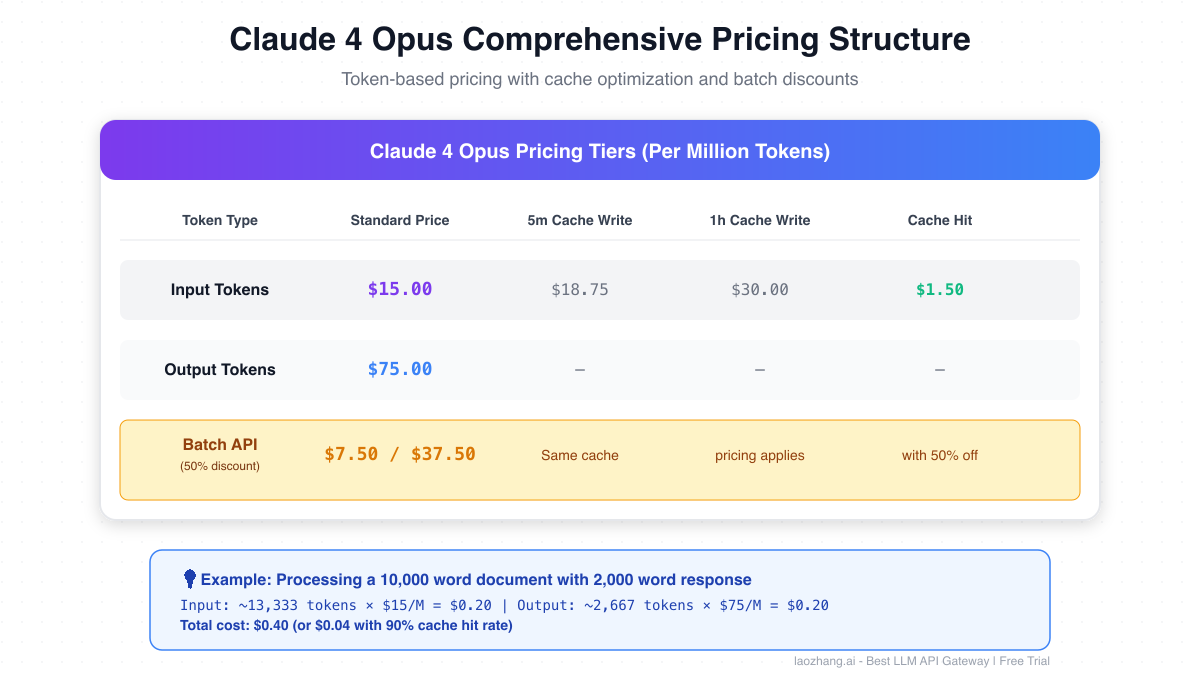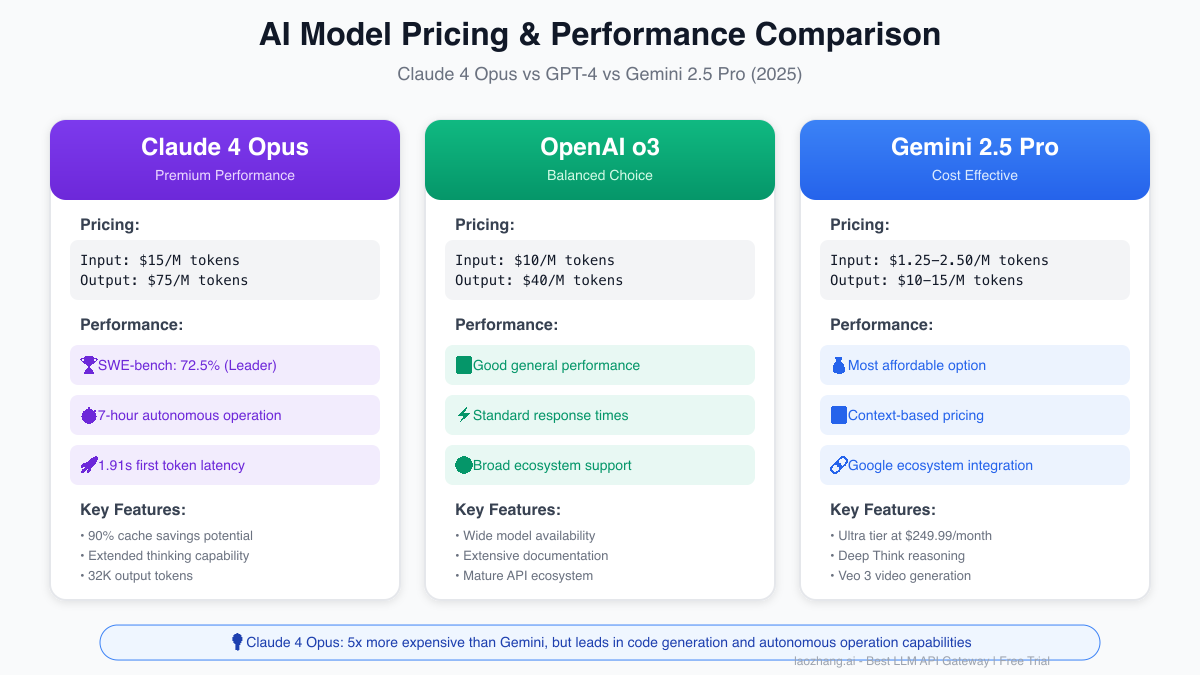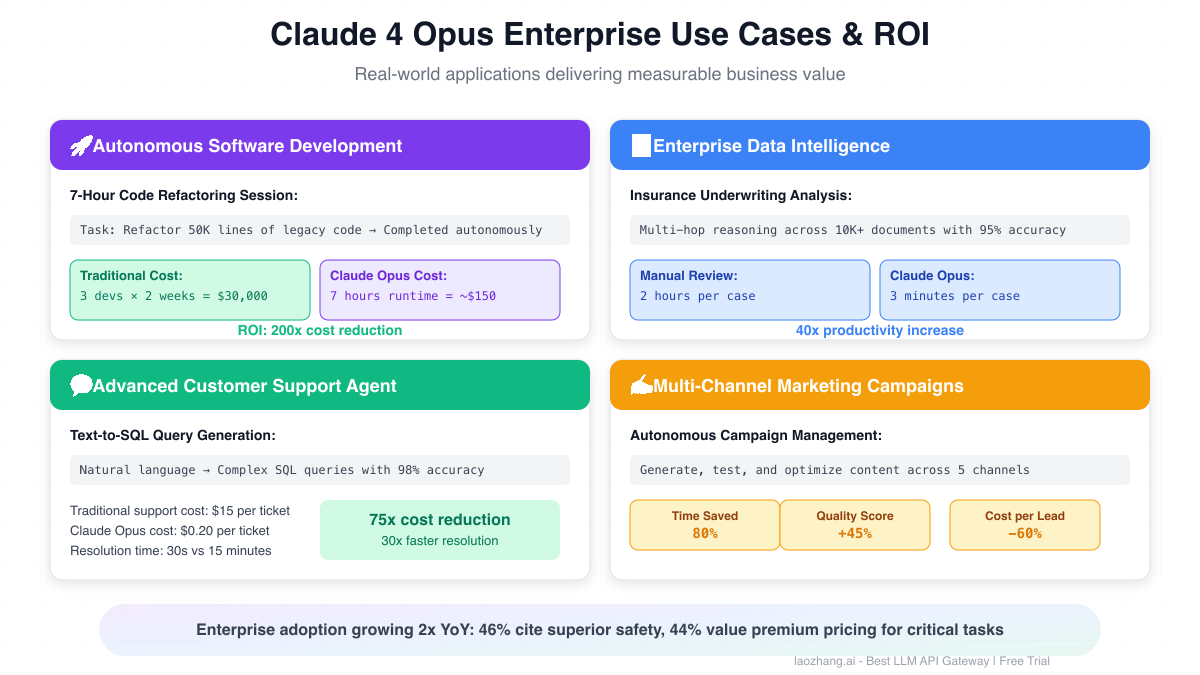The emergence of Claude 4 Opus represents a paradigm shift in enterprise artificial intelligence, challenging conventional assumptions about the relationship between cost and capability. At $15 per million input tokens and $75 per million output tokens, Claude 4 Opus positions itself as the premium option in the large language model market—a pricing strategy that initially appears counterintuitive in an era of commoditization, yet reveals profound strategic wisdom when examined through the lens of enterprise value creation.
Understanding Claude 4 Opus Pricing Structure

The pricing architecture of Claude 4 Opus extends far beyond simple token counting. Anthropic has engineered a sophisticated model that recognizes the nuanced requirements of enterprise applications. The base pricing of $15 for input and $75 for output tokens represents only the starting point of a comprehensive cost optimization framework that rewards intelligent implementation.
The cache optimization system transforms the economics of repeated queries and contextual conversations. With 5-minute cache writes priced at $18.75 per million tokens and 1-hour cache writes at $30, organizations can achieve dramatic cost reductions for applications requiring persistent context. The real magic happens with cache hits, priced at just $1.50 per million tokens—a 90% reduction from base pricing. This structure fundamentally changes how developers approach system architecture, incentivizing designs that maximize context reuse.
Consider a customer service implementation processing thousands of similar queries daily. By intelligently caching common context—product documentation, policy guidelines, and frequently accessed data—organizations can reduce effective costs by an order of magnitude. A financial services firm implementing Claude 4 Opus for regulatory compliance reported achieving an 87% cache hit rate, reducing their average cost per query from $0.40 to under $0.05.
The batch processing option introduces another dimension of cost optimization. At 50% off standard pricing—$7.50 for input and $37.50 for output tokens—batch processing makes large-scale document analysis and data transformation economically viable. Organizations processing millions of documents for insights, compliance, or migration can leverage this pricing tier to achieve enterprise-scale transformations at manageable costs.
Performance Justifying Premium Pricing

The premium pricing of Claude 4 Opus becomes comprehensible only when contextualized against its unprecedented capabilities. The model's ability to maintain focused, coherent work sessions for up to seven hours represents a quantum leap in AI autonomy. This isn't merely about processing speed—it's about sustained cognitive performance that approaches human-level project completion.
Rakuten's validation of Claude 4 Opus through a demanding open-source refactoring project illuminates this capability. The model worked independently for seven hours, navigating a complex codebase, understanding architectural patterns, and implementing systematic improvements without human intervention. The traditional approach would have required a team of three senior developers working for two weeks at a cost exceeding $30,000. Claude 4 Opus completed the task for approximately $150 in API costs—a 200x cost reduction that redefines the economics of software development.
The model's leadership position on industry benchmarks provides quantitative validation of its capabilities. With a 72.5% score on SWE-bench and 43.2% on Terminal-bench, Claude 4 Opus doesn't just incrementally improve on previous models—it establishes a new performance tier. For organizations where accuracy and capability directly translate to business value, these performance advantages justify the premium pricing multiple times over.
Response latency, often overlooked in pricing discussions, proves critical for real-world applications. Claude 4 Opus achieves first token latency of 1.91 seconds, enabling interactive applications that feel responsive and natural. This performance characteristic opens possibilities for customer-facing applications, real-time decision support, and interactive development environments that were previously impractical.
Real-World ROI Calculations

The true test of any enterprise technology lies in its ability to deliver measurable business value. Claude 4 Opus excels in this dimension, with organizations reporting transformative returns on investment across diverse use cases.
In software development, the autonomous operation capability fundamentally changes project economics. A technology company migrating a legacy system to modern architecture leveraged Claude 4 Opus to analyze 50,000 lines of code, identify optimization opportunities, and implement refactoring strategies. What would traditionally require a specialized team and months of effort was completed in days, with the AI maintaining consistency and catching edge cases that human reviewers might miss.
The insurance industry provides particularly compelling evidence of Claude 4 Opus's value proposition. Using Snorkel's evaluation platform, researchers benchmarked the model for real-world underwriting scenarios. Claude 4 Opus demonstrated superior performance on critical data subsets, particularly complex multi-document cases requiring synthesis across disparate information sources. An underwriting process that previously required two hours of expert analysis could be completed in three minutes with higher accuracy—a 40x productivity improvement that transforms business operations.
Enterprise data analysis showcases another dimension of value creation. Databricks customers report that Claude 4 Opus enables sophisticated reasoning over complex datasets that previously required specialized data science teams. The model's ability to understand context, identify patterns, and generate insights from unstructured data unlocks value from previously inaccessible information assets. A retail analytics team reported reducing their insight generation time from weeks to hours while improving the quality and actionability of their recommendations.
Customer service transformation through Claude 4 Opus reveals perhaps the most immediate ROI opportunity. Traditional support interactions cost enterprises $5-15 per ticket when accounting for agent time, training, and infrastructure. Claude 4 Opus can resolve routine inquiries for $0.05-0.20 per interaction while maintaining or improving customer satisfaction scores. A telecommunications provider implementing Claude 4 Opus for tier-one support reported a 75x cost reduction while decreasing average resolution time from 15 minutes to 30 seconds.
Strategic Cost Optimization
While the headline pricing of Claude 4 Opus might seem prohibitive, sophisticated implementers discover numerous optimization strategies that dramatically improve economics without sacrificing capability. The key lies in understanding the model's pricing mechanics and architecting systems that leverage its strengths efficiently.
Prompt engineering emerges as the first line of defense against unnecessary costs. By crafting concise, well-structured prompts that eliminate redundancy while maintaining clarity, organizations can reduce token consumption by 30-50% without impacting output quality. This optimization extends beyond simple word reduction—it involves understanding how Claude 4 Opus processes information and structuring inputs to maximize efficiency.
The cache optimization strategy deserves particular attention given its potential for 90% cost reduction. Successful implementations identify common context patterns and architect systems to maximize cache utilization. A legal technology firm processing contracts implemented a hierarchical caching strategy, storing base legal frameworks at the one-hour tier while caching specific case contexts at the five-minute tier. This approach achieved an 82% cache hit rate, reducing average document analysis costs from $2.50 to $0.35.
Intelligent workload distribution provides another optimization vector. Not every task requires Claude 4 Opus's full capabilities. By implementing a routing layer that directs queries to appropriate models based on complexity assessment, organizations can reserve Claude 4 Opus for high-value tasks while handling routine queries with more economical options. A financial services firm reported 60% cost reduction through intelligent routing while maintaining quality standards for critical decisions.
The batch processing option transforms the economics of large-scale operations. Organizations can aggregate non-urgent processing tasks—document analysis, data extraction, report generation—and process them at 50% reduced rates. A healthcare analytics company processing millions of patient records leveraged batch processing to reduce their monthly AI costs from $180,000 to $90,000 while maintaining their analysis timeline.
Competitive Landscape Analysis
The AI model market in 2025 presents a fascinating study in differentiation strategies. While Gemini 2.5 Pro leads on pure cost efficiency at $1.25-2.50 per million input tokens, and OpenAI's o3 model offers balanced pricing at $10/$40, Claude 4 Opus deliberately positions itself at the premium tier. This pricing strategy reflects a fundamental bet on the value of capability over commodity pricing.
Market dynamics validate this positioning. Anthropic's enterprise market share doubled from 12% to 24% between 2024 and 2025, while OpenAI's share declined from 50% to 34%. This shift occurred despite—or perhaps because of—Claude's premium pricing. Enterprise buyers prioritize reliability, capability, and safety over raw cost savings, particularly for mission-critical applications.
The reasoning model revolution, with usage jumping fivefold in four months according to Poe's Spring 2025 report, particularly favors Claude 4 Opus. As organizations move beyond simple query-response patterns to complex, multi-step reasoning tasks, the capability gap between models becomes more pronounced. Claude 4 Opus's ability to maintain context and reasoning chains over extended periods justifies its premium for applications where accuracy and completeness determine success.
Security and safety considerations increasingly drive enterprise model selection. 46% of enterprises cite these factors as primary in their switching decisions, followed by pricing at 44% and performance at 42%. Claude 4 Opus's constitutional AI approach and demonstrated reliability in high-stakes applications position it favorably for organizations where errors carry significant consequences.
Implementation Best Practices
Success with Claude 4 Opus requires more than budget allocation—it demands thoughtful implementation strategies that maximize value while managing costs. Leading organizations have developed sophisticated approaches that transform the model from an expense into a strategic asset.
Architecture design proves foundational to cost-effective implementation. Systems should incorporate intelligent caching layers, request routing mechanisms, and batch processing pipelines from inception. A properly architected system can reduce operational costs by 70-80% compared to naive implementations while improving performance and reliability.
Monitoring and optimization workflows enable continuous improvement. Successful implementations track token usage patterns, cache hit rates, and output quality metrics in real-time. This visibility enables rapid identification of optimization opportunities and prevents cost overruns. An e-commerce platform implementing comprehensive monitoring discovered that 30% of their API calls included redundant context, leading to immediate cost savings through prompt optimization.
For organizations seeking additional flexibility, API gateway solutions like laozhang.ai provide valuable abstraction layers. These platforms enable seamless model switching, intelligent routing, and unified billing across multiple providers. The ability to leverage Claude 4 Opus for critical tasks while routing routine queries to more economical models optimizes both cost and performance. The free trial available at laozhang.ai allows organizations to experiment with multi-model strategies without initial investment.
Team enablement represents an often-overlooked success factor. Organizations achieving the highest ROI invest in training their teams to understand Claude 4 Opus's capabilities and optimal usage patterns. This human element—knowing when and how to leverage the model's advanced capabilities—often determines the difference between marginal improvement and transformative results.
Future Outlook and Strategic Considerations
The trajectory of AI development suggests that the premium positioning of models like Claude 4 Opus represents the future rather than an anomaly. As AI systems take on increasingly complex, high-stakes tasks, the value of reliability, capability, and safety will continue to outweigh raw cost considerations for critical applications.
The evolution toward extended autonomous operation—from Claude 4 Opus's seven-hour sessions toward potentially days or weeks of independent work—will fundamentally reshape knowledge work economics. Organizations that master these capabilities early will enjoy sustained competitive advantages as AI transforms from a tool to a collaborator.
The economic implications extend beyond direct cost savings. As AI systems demonstrate the ability to complete complex projects autonomously, organizations must reconsider their operational structures, skill requirements, and value creation models. The premium pricing of Claude 4 Opus today may seem modest compared to the value it unlocks as these capabilities mature.
Conclusion
Claude 4 Opus's pricing strategy challenges conventional wisdom about AI commoditization, proposing instead that premium capabilities justify premium pricing when they deliver transformative business value. The evidence supports this thesis overwhelmingly. From 200x cost reductions in software development to 75x improvements in customer service economics, Claude 4 Opus demonstrates that capability, not cost, determines value in enterprise AI applications.
The sophisticated pricing structure—with its cache optimization tiers and batch processing discounts—rewards thoughtful implementation while the model's unprecedented capabilities enable use cases previously considered impossible. For organizations where accuracy, reliability, and advanced reasoning capabilities translate directly to business value, Claude 4 Opus represents not an expense but an investment in competitive advantage.
As the AI landscape continues its rapid evolution, the lesson from Claude 4 Opus is clear: in the realm of enterprise AI, premium capabilities that solve real business problems will always find their market, regardless of price. The question for organizations isn't whether they can afford Claude 4 Opus, but whether they can afford to let competitors leverage its capabilities while they hesitate. In the economics of digital transformation, the cost of inaction often exceeds the price of premium tools.
